Last Updated on January 4, 2024 by Kittredge Cherry
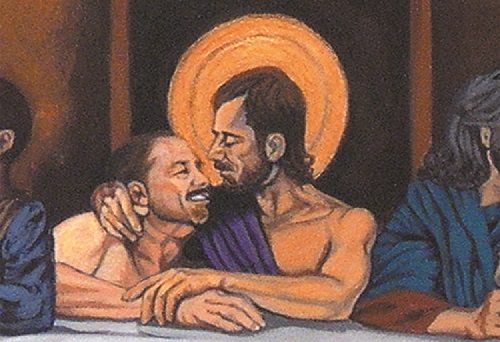
John the Evangelist is commonly considered to be Jesus’ “Beloved Disciple” — and possibly his lover. His feast day is Dec. 27.
The love between Jesus and John has been celebrated by artists since medieval times. And the idea that they were same-sex lovers has been inspiring queer people and causing controversy for centuries. The possibility of John as genderfluid or genderqueer is also being explored because John is often portrayed as younger and beardless, which is more “feminine” by traditional standards.
John was an apostle of Jesus and is the presumed author of the Gospel of John, the Book of Revelation and the Epistles of John. The Bible describes their warm relationship on multiple occasions. John and his brother James left their lives as a fishermen in Galilee to follow Jesus. He nicknamed them “Sons of Thunder,” perhaps referring to their fiery temperaments or powerful voices. John participated in many of the main events in Christ’s ministry. He was one of the three who witnessed the raising of Jairus’ daughter, the transfiguration and Jesus’ agony in Gethsemane.
The unnamed “disciple whom Jesus loved” is referenced five times in the gospel of John (John 13:23, 19:26, 20:22, 21:7, 20). The author identifies himself as the Beloved Disciple in the final chapter. Early church tradition ascribes authorship directly to John. Other identities proposed for the Beloved Disciple include Lazarus, Thomas, Mary Magdalene and even Judas, the disciple who betrayed Jesus. Because the Beloved Disciple is left unnamed, each believer is free to imagine or be that beloved disciple in their own way.

Jesus and John lean on each other in a rainbow image from “Heavenly Homos, Etc.: Queer Icons from LGBTQ Life, Religion, and History” by Jan Haen.
No other male disciples were present at the crucifixion. From the cross, Jesus entrusted the Beloved Disciple and his mother Mary into each other’s care. Legends say that John took her with him to the Turkish city of Ephesus, where the major temple to the goddess Artemis was rededicated to Mary.
The gospel of John, the most mystical gospel, is attributed to John. This gospel is also noted for its gender inclusivity in portraying the important role of women such as Mary and Martha of Bethany, the Samaritan woman and Mary Magdalene. In John’s gospel, the Beloved Disciple was the first to reach the empty tomb of Jesus, the first to believe in his resurrection and the first to recognize the risen Christ at the miraculous catch of fish.
After Jesus was crucified, John went on to build a close, loving relationship with his younger disciple and scribe, Prochorus, bishop of Nicomedia. Tradition says that John was the only one of Christ’s original 12 apostles to live to old age, and the only one not killed for his faith. He died in Ephesus around 100 AD.
Added in 2023: New and medieval images of Beloved Disciple
Two images of Jesus and the Beloved — one new and one from medieval times — came to the attention of Q Spirit in 2023.
“Bridegroom and the Beloved” by Matthew of Queer Catholic Icons
Their halos appear to be linked rings in “Bridegroom and the Beloved” by Matthew, a practicing Roman Catholic who shares his artwork at Queer Catholic Icons on Instagram as @queer.catholic.icons. He adapts the traditional iconography by making both figures look youthful, so there is little or no age gap between the Bridegroom and the Beloved.
A 15th-century Ethiopian diptych showing a kiss between Christ and his beloved is on display at the Metropolitan Museum of Art in New York as part of the “Africa & Byzantium” exhibit through March 3, 2024. Then it will move to the Cleveland Museum of Art in Ohio from April 14 to July 21, 2024.
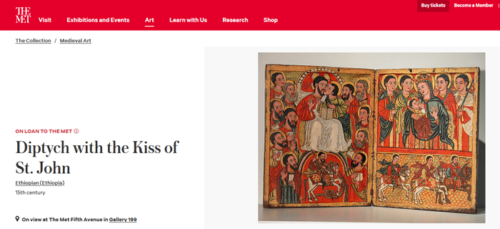
Screenshot of “Diptych with the Kiss of John” on the Metropolitan Museum of Art website
Museum materials give it alternate titles as either “Diptych with the Kiss of Christ to His Beloved” or “Diptych with the Kiss of St. John.” The hinged wooden panels include a painting of their kiss next to an inscription that reads, “Picture of Our Lord, how he kissed his beloved John.” On Jesus’ lap is a book open to the first words of John’s gospel “In the beginning was the Word…”
Did Jesus and John share an erotic relationship?
Whoever he or she was, the Beloved Disciple reclined next to Jesus at the Last Supper, resting his head on Jesus’ chest. There is even a medieval European tradition that John and Jesus were the bridal couple at the Cana wedding feast. Jesus performed his first miracle at Cana by turning water into wine. The Bible tells the story in John 2:1-11 without ever naming who was getting married. But the apocryphal Acts of John state that John broke off his engagement to a woman to “bind himself” to Jesus. The idea that Jesus wed John at Cana is discussed by Gerard Loughlin in the introduction to “Queer Theology: Rethinking the Western Body.”
One of the earliest images of John and Jesus together is a little-known 12th-century miniature, “The Calling of St. John.” It depicts two scenes: Christ coaxing the disciple John to leave his female bride and follow him, and John resting his head on Jesus’ chest. Jesus cups the chin of his beloved, an artistic convention used to indicate romantic intimacy. The Latin text means, “Get up, leave the breast of your bride, and rest on the breast of the Lord Jesus.”
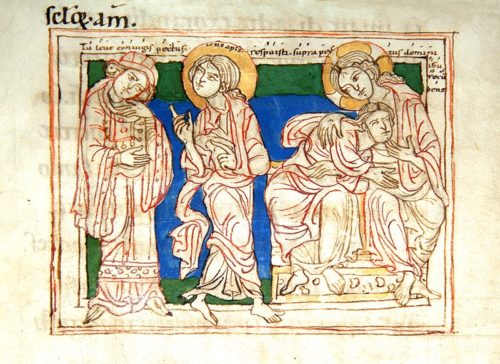
“The Calling of Saint. John,” a 12th-century miniature
This scenario is also illustrated in the 1865 drawing “The Bride, Bridegroom and Sad Love” by Solomon Simeon, a Jewish British painter whose art career was cut short when he was arrested for homosexual acts. It can be viewed at this link (warning: nudity). It portrays a melancholy trio where a Christ figure or male angel holds hands with a groom kissing a bride. Subtle and not-so-subtle homoerotic themes underlie much of Simeon’s artwork. Oscar Wilde, another 19th-century Briton whose creative career was ruined by an arrest for homosexuality, lamented when he was forced to sell his collection of Simeon art.
An entire chapter is dedicated to John as the bride of Christ in the 2013 book “Saintly Brides and Bridegrooms: The Mystic Marriage in Renaissance Art” by Carolyn D. Muir, art professor at the University of Hong Kong.
The idea that Jesus and his Beloved Disciple had a sexual relationship was publicly discussed in early 16th century, when English playwright Christopher Marlowe was tried for blasphemy on the charge of claiming that “St. John the Evangelist was bedfellow to Christ and leaned always in his bosom, that he used him as the sinners of Sodoma.” In 1550 Francesco Calcagno, a citizen of Venice, was investigated by the Inquisition for making the heretical claim that “St. John was Christ’s catamite,” which means a boy or young man in a pederastic sexual relationship with an older man.
 Many modern scholars have expressed belief that Jesus and his Beloved Disciple shared a an erotic physical relationship. They include Hugh Montefiore, Robert Williams, Sjef van Tilborg, John McNeill, Rollan McCleary, Robert E. Goss and James Neill. A thorough analysis is included in “The Man Jesus Loved: Homoerotic Narratives from the New Testament
Many modern scholars have expressed belief that Jesus and his Beloved Disciple shared a an erotic physical relationship. They include Hugh Montefiore, Robert Williams, Sjef van Tilborg, John McNeill, Rollan McCleary, Robert E. Goss and James Neill. A thorough analysis is included in “The Man Jesus Loved: Homoerotic Narratives from the New Testament” by the late Theodore Jennings, who served as Biblical theology professor at Chicago Theological Seminary. He finds the evidence “inconclusive” as to whether the beloved disciple was John, but it leaves no doubt that Jesus had a male lover.
“A close reading of the texts in which the beloved disciple appears supports the hypothesis that the relationship between him and Jesus may be understood as that of lovers. As it happens, both Jesus and the beloved are male, meaning that their relationship may be said to be, in modern terms, a ‘homosexual’ relationship,” Jennings writes (p. 34).
Religion professor Tat-siong Benny Liew sparked controversy by suggesting that Jesus was a genderfluid drag king with queer desires. Conservatives attacked his chapter “Queering Closets and Perverting Desires: Cross-Examining John’s Engendering and Transgendering Word across Different Worlds” in the 2009 book “They Were All Together in One Place? Toward Minority Biblical Criticism.”
The homoeroticism of the relationship is also explored in the chapter on the Beloved Disciple in
“The Double: Male Eros, Friendships, and Mentoring–from Gilgamesh to Kerouac” by Edward Sellner.
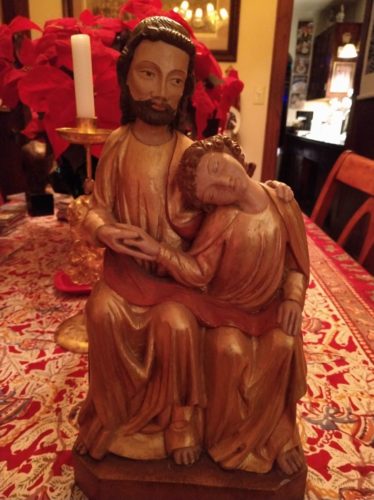
This statue of Jesus and the Beloved Disciple comes from the collection of author Edward Sellner. He commissioned it from a wood carver in Brittany, France.
While the earliest depictions emphasize the closeness between Jesus and the Beloved Disciple, modern translations keep putting more distance between them. Gay Christian author Chris Glaser writes on his blog,
In ‘As My Own Soul: The Blessing of Same-Gender Marriage,’ I pointed out how recent translations have distanced the Beloved Disciple, believed to be John, from Jesus. In the King James Version “the disciple whom Jesus loved” is “leaning on Jesus’ bosom.” The Revised Standard Version describes him as “lying close to the breast of Jesus.” But the New Revised Standard Version and the New Jerusalem Bible have the Beloved Disciple simply “reclining next” to Jesus. As the Beloved disciple moves farther away from Jesus with newer versions, I imagine in the next translation he will be in another room!
The queer history of their relationship is presented in the video “Before Stonewall, Episode 5: The Myth of the Beloved Disciple” by historian Chad Denton.
Jesus embraces the Beloved Disciple in historical art
A newly discovered painting of Jesus and his Beloved Disciple was recently unveiled to the public for the first time in 450 years. They appear in the Last Supper by Italian nun Plautilla Nelli.
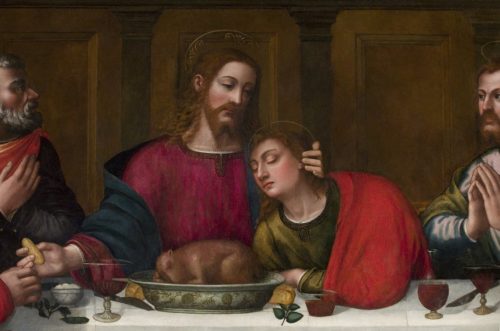
John and Jesus in Last Supper by Plautilla Nelli, 1658 (Wikipedia)
It is the world’s first known depiction of the Last Supper by a woman. Nelli was a Dominican nun and the first woman painter of Renaissance Florence. Her life-size Last Supper is about 23 feet long, almost as big as Da Vinci’s famous version. The Dominican nun was a self-taught artist with many patrons, including women.
Now-iconic images of the loving embrace between John and Christ apparently originated during the early 1300s in German convents in the Rhineland and Swabia. These were devotional images intended to help viewers deepen their connection to Christ. Prolific artists created many versions. Today one of them is housed in the Cleveland Museum of Art in Ohio.
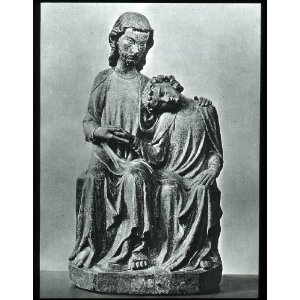
“Christus Johannes Gruppe” (Christ John Group) by the unknown Master of Oberschwaben, oak sculpture, 1320.
The subject is known as “Christus Johannes Gruppe” (Christ John Group) or Johannesminne (love of John), with minne being a Middle High German word for erotic-emotional love. Many of these images were actually created for women, not men, to contemplate. Most if not all of the Johannesminne statues were altarpieces for Dominican convents and nunneries.
For example, “Christus Johannes Gruppe” (Christ John Group) by the unknown Master of Oberschwaben spent many centuries in an Augustinian convent in Inzigkofen, a town in the region of Sigmaringen in southwestern Germany. A museum in Berlin acquired in it the early 20th century, and it is now housed in the Bode Museum of the Prussian Cultural Heritage Foundation.
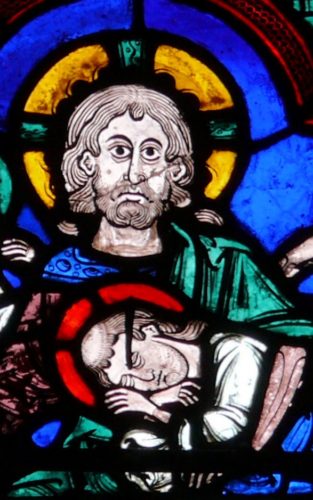
Jesus embraces the Beloved Disciple at the Last Supper in a 13th-century stained-glass window from Cathedral of Saint Etienne in Bourges, France. (Wikipedia)
The history, eroticism, appeal and impact of these devotional images is explored in “The Late Medieval Andachtsbild,” an unpublished essay by Daniel G. Conklin, a retired Anglican priest in Berlin. He writes,
“One common characteristic of the Johannesminne is that the figure of John seems a bit gender-ambiguous, i.e. it looks like he might be a “she.” Considering the place where these images arose and were beheld, it takes no great stretch of the imagination to envision the effect of the Johannesminne on a cloistered young woman who was well versed in the Cistercian “bridal” mysticism of St. Bernard of Clairvaux…. The Johannesminne is an image of profound tenderness embued with a kind of gentle eroticism. As an altarpiece it must have been a constant reminder of the connection between the Lord’s Last Supper and the celebration of the Mass and it surely reinforced the pious conviction that in the Eucharistic bread and wine the risen Christ “dwells in us and we in him” in a profound and intimate way.”
Conklin goes on to identify homoeroticism as one source of the image’s enduring power:
“The popularity of the Johannesminne – then and now – may also stem from the fact that this is an image involving love and tenderness between two adult males. The fact that this Andachtsbild arose in monasteries, communities of same-sex individuals, probably comes as no surprise. Its power to awaken faith and delight in close communion with Christ is perhaps not its only appeal. The Johannesminne has become perhaps even more appealing in our day in which people of the same gender in committed relationships seek some form(s) of faith confirmation of who they are and whose they are. The Johannesminne may very well serve as a mirror as well as a model for many, not only same-sex oriented persons.”
In Germany the Johannesminne image remains so important that it has even been made into a postage stamp. Its influence may also live on in today’s popular “Sacred Heart of Jesus” icons, which show the physical heart of Jesus in his chest. Conklin explains:
The Johannesminne as an altarpiece not only visualized the intimate communion of the Eucharist, but also seems to have been one of the essential sources for the unfolding of the “Sacred Heart of Jesus” mysticism which developed later, but had its beginnings in this Andachtsbild. The beholder could imagine John, i.e. the beholder him/herself, hearing the heartbeat of Jesus while leaning on his chest. The communion is that “close.”
Another early sculpture in this style is “St. John Resting on Jesus’ Chest,” circa 1320, which is housed at the Museum Mayer van den Bergh in Antwerp. It can be seen online at the Web Gallery of Art. The sculpture was created by Master Heinrich of Constance for the the Dominican convent of St. Catherine’s valley in Switzerland. Wikimedia Commons displays a set of 15 statues of Johannesminne in Germany at this link.
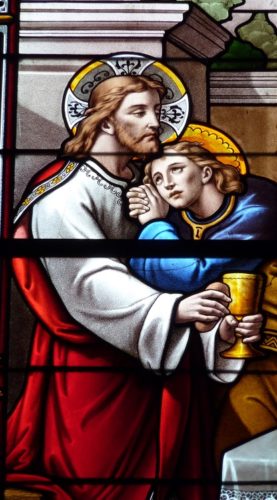
Jesus and Apostle John in stained-glass window at Catholic Church of the Sacred Heart of Jesus (Eglise du Sacre-Coeur) in Lille, France, 1890 (Wikipedia)
Antique French religious medals feature some rare and beautiful images of Jesus and his Beloved Disciple. It is unusual to find a medallion with an image of Christ other than the crucifixion.
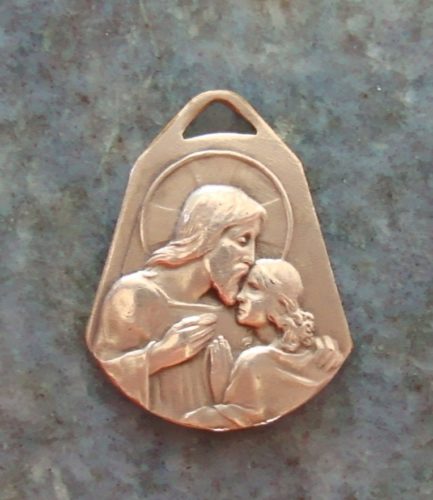
Jesus tenderly kisses John’s forehead before giving him communion bread in a vintage French religious medal from the 1930s. It was available from the Fred’s Prayer shop on Etsy.
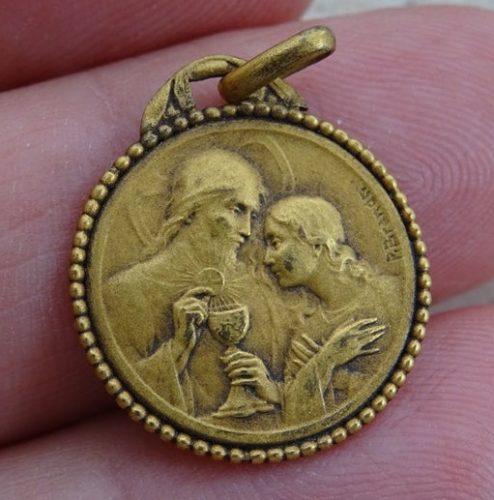
Jesus and his Beloved Disciple John gaze lovingly into each other’s eyes in this antique French religious medal. It is available from the Religious shop on Etsy.
Contemporary icons show the Beloved Disciple
Artists continue to make new icons of Jesus and John in traditional style. One of the newest is a contemporary Byzantine icon available at the Angelicon Etsy shop. It was painted in egg tempera by the mother-daughter team of Eka and Ari in their small workshop in Crete, Greece.
Contemporary Byzantine icon of the Beloved Disciple. The original was available from the Angelicon Etsy shop.
John the Beloved Disciple in contemporary art
Over the centuries many artworks have illustrated the deep love between Jesus and his Beloved Disciple. A variety of contemporary artists have done new interpretations of John and Jesus together. Many of the historic images appear to show John as much younger than Jesus, but their age difference is de-emphasized and they both look like grown men in most of the newer images. Perhaps the reason for the change is growing awareness of the church’s complicity with pedophile priests, combined with the with the need for modern gay couples for find religious affirmation.
One of the newer images is “Beloved Disciple” by James Day. He studied liturgical art and queer theology at Episcopal Divinity School in Cambridge, Massachusetts, earning a Master of Arts degree in theology before returning home to central Maine. When not caring for care for his aging mother and disabled partner, he puts his hands to a variety of visual and fiber arts, primarily focused on queer spirituality.” Day’s painting of the “Beloved Disciple” hung in the EDS Chapel in fall 2016.

“Beloved Disciple” by James Day
The wedding between Jesus and his beloved disciple is one of the LGBT Christian themes explored in monumental nude paintings by gay New Zealand artist Christopher Olwage. He gives a sacred gay interpretation to the wedding feast at Cana. Olwage is an LGBTQ activist and gender-bending ballet dancer who reigned as Mr. Gay World in 2013.
 |
| “Crucifixion” by Christopher Olwage |
Another recent work is the 2012 icon “Jesus and the Beloved Disciple” by Laurie Gudim. Based in Colorado, Gudim is an artist, Jungian psychotherapist and progressive Episcopalian. Her work uses a motif dating back at least to the 13th century.The long artistic tradition depicts John as the Beloved Disciple resting his head on the breast of Jesus.
This sculpture spent many centuries in an Augustinian convent in Inzigkofen, a town in the region of Sigmaringen in southwestern Germany. A museum in Berlin acquired in it the early 20th century, and it is now housed in the Bode Museum of the Prussian Cultural Heritage Foundation.
Beloved Disciple in poetry and music
Various poets have written about the love between Jesus and John from a gay or queer viewpoint. A gay man prays, wondering if Jesus felt sexual attraction to John, in a poem by longtime LGBTQ church activist and poet Louie Clay (né Louie Crew).
What did you feel when your beloved John
lay across your lap casually?
He wrote these lines raising the possibility of a queer Christ in his 1980 poem “Lutibelle Prays: William Werc’s Prayer.” In 1974 Clay founded Integrity USA, the national Episcopal LGBTQ organization. The whole poem is posted at this link.
Another poem that addresses the homoerotic love between Jesus and John as is “The Third Dance of Christmas: A Fiddle Dance for St. John’s Day” by a poet who wants to be known only as Joe. It begins:
Sweet John was a danceron the shore of old Capernauma lovely boy not fit for fishingor carpentry, or marrying.They tell he left his empty boatfor the sake of the bold young fellowwho looked at him that April mornand said, my love, come follow.
The interplay of humanity, divinity and the “honeyed warmth of love, of starlight” between Jesus and John is explored in the poem “A Portrait of John at the Last Supper” by trans gay poet Keaton St. James. The full poem is available at this link.
Queer poet Jim Wise references John in “Seminarians,” an unpublished poem from his “Queer Psalter” collection:
After a long day of
watching him preach
his gospel, which was
nothing more than
begging people to
actually give a damn
about one another,
we wanted to be his
Beloved John, his Lazarus,
his place to lay his head.
For more poetry by Wise, click here.
Contemporary America singer-songwriter Sufjan Stevens merges homoerotic desire and spiritual longing in the song “John My Beloved.” Many listeners hear references in the song to the love between Jesus and his disciple John as well as to modern gay sexual encounters. The song is available on a YouTube video and the album from his album “Carrie and Lowell.”
Beloved Disciple in religious fiction
LGBTQ interpretations of the Beloved Disciple in religious fiction include:
“The Gay Disciple: Jesus’ Friend Tells It His Own Way” by John Henson. Starting with the gay Beloved Disciple, various Bible characters tell their experiences with Jesus in their own words. The author believes that the Beloved Disciple was Lazarus. “Maybe for my lifetime, maybe for many hundreds or even thousands of years, my story would be taboo, until that day came when Christians would no longer be afraid of love,” he writes. The author is a retired Baptist minister who graduated in history and theology from Southampton and Oxford Universities in the United Kingdom. Brenner is a San Francisco author who served as a parish pastor for 10 years and in the hospice field for 25 years. Published in 2006 by John Hunt Publishing.
“Abominations: A Novel” by Paul R. Brenner. “Abominations: A Novel” by Paul R. Brenner. A man describes his struggles in the years after the death of his lover, a radical young rabbi named Jesus. As leader of a sacred community in Jerusalem, the Beloved Disciple faces danger when fanatics try to cleanse Judaea of all impurities and foreign influences, including Greek love. Mary Magdalene and Last Supper host Joanna are also caught in the conflict. The He flees to become a visiting scholar at the Temple of the Muses and great library in Alexandria, but his life continues to be disrupted by ethnic conflict and fascinating relationships with people such as Markos, the sexy, wealthy young Greek who pursues him. The narrator never reveals his name, but this Beloved Disciple comes from a wealthy, Hellenized family. Published in 2008 by Xlibris.
Beloved Disciple excerpt from Jesus in Love: A Novel
I became distracted by the not unwelcome presence of somebody standing close behind me, closer than necessary in the loosely packed crowd. I sensed that it was John, and spun around to see him planted there like a tall cedar tree. He leaned against me, eyes flashing. “I can’t wait for the Messiah to come. I’ve seen him in visions.”
“Really? Tell me what you remember.” It was exciting to find someone who was aware of God’s efforts to communicate.
“The Messiah is like a gentle lamb who sits on a throne with a rainbow around it. And yet his eyes flame with fire, and a sharp sword comes out of his mouth to strike down evildoers.”
“The truth is large,” I said.
“Are you saying my vision isn’t true?” he challenged.
“No, I’m not saying that. I expect that you will see more.”
When John smiled, his faced crinkled into a fascinating landscape of wrinkles. His eyes felt black and mysterious like the midnight sky as they roamed over me. “Do you want a prayer partner tonight?” he asked.
If anyone else had asked, I would have said no, but I looked again at John’s handsome, bejeweled soul and his long, sinewy body.
“Sure,” I agreed impulsively.
Only then did I notice that the Baptist had finished preaching. John steered me toward the caves where the Baptist and his inner circle of disciples lived. Lower-ranking disciples were ready with water vessels and towels to assist everyone with ritual purification before we ate a spartan meal of locusts and wild honey. One of them approached me.
“Wash up, and we’ll get together after supper,” John said as we parted.
Beloved Disciple prayers
Q Spirit’s Litany of Queer Saints includes these lines:
Saint John, Beloved Disciple, apostle who shared special love with Jesus, pray for us.
Links related to the Beloved Disciple
___
To read this article in Spanish, go to:
San Juan el Evangelista: Discípulo Amado de Jesús (Santos Queer)
___
Top image credit: Detail from Study for The Last Supper by Becki Jayne Harrelson
___
This post is part of the LGBTQ Saints series by Kittredge Cherry. Traditional and alternative saints, people in the Bible, LGBTQ martyrs, authors, theologians, religious leaders, artists, deities and other figures of special interest to lesbian, gay, bisexual and transgender and queer (LGBTQ) people and our allies are covered.
This article was originally published on Q Spirit in December 2016, was expanded with new material over time, and was most recently updated on Dec. 27, 2023.
Copyright © Kittredge Cherry. All rights reserved.
Qspirit.net presents the Jesus in Love Blog on LGBTQ spirituality.




















To suggest that the Apostle John and Jesus were lovers is ludicrous. There is not one shred of evidence here other than to try to twist Scripture into saying that the “agape” love shared between these two was somehow “eros” which the original languages DO NOT SAY.
This is as big a stretch as trying to say David and Jonathan from the Old Testament were lovers when the Hebrew language used says nothing about that relationship.
Jesus was without sin hence he would have never done something that is defined as a sin by god in the old testamony. Our modern society of the west is extremely sexualized, which becomes very visible once one starts traveling into other cultures. Kisses on the cheeks are already considered “gay” by many people in the west, but are performed by many in other nations. It is barely imaginable, how different it was 2000 years ago. The simplest explanation for John and Jesus, is that the writer was simply so innocent and so far from gay thoughts, that he did not think about it a second. Also there are multiple old greek words for love and only one of them is describing the romantic love, which was not used in this context.
He will smile sweetly at the admiring lover; he will show appreciation for the other’s friendship, advice, and assistance. He will allow the lover to greet him by touching, affectionately, his genitals and his face, while he looks, himself, demurely at the ground. … To touch the face of the beloved younger man as he looks demurely down is a hallmark of homosexual love and courtship in the ancient Greek world. The older man will touch the younger’s chin and gently raise the chin until their eyes meet. https://en.wikipedia.org/wiki/Pederasty_in_ancient_Greece
John the son of Zebedee was described as fair of face, very handsome with blue eyes and light hair: yes, Jesus’s lover was a beautiful, young hottie. No wonder Jesus likes to touch him and let him rest his head on Jesus’s chest as they reclined on their dining couch. Also, Jesus, many times, preached against adultery (violation of marriage vows) but never against homosexuality, which was very prevalent and accepted in their Greco-Roman world.
The only evidence for a homosexual relationship which you presented in this article were subjective opinions by various authors, without any stated evidence to back up any of those opinions (one was based on a “close reading” of Biblical passages, which is just a fancy way of describing putting a personal “spin” on well-known passages which do not give any explicit description of romance or sex). As for the idea that modern translations are increasingly moving away from describing the beloved disciple leaning against Jesus’ chest: that’s partly because modern scholars who know something about the historical context have increasingly pointed out that the original language is likely just describing the disciple tilting his head back to ask Jesus a question rather than resting his head on Jesus’ chest, since the people of the time often ate while reclining on separate couches arranged so that the head of any given person was right in front of the chest area of the next person to their right-hand side, hence to ask the question which this passage explicitly describes (i.e. it says the disciple was asking Jesus a question at the time), the disciple would need to tilt his head back toward the chest area of the person he was speaking to if that person was to his right and hence also slightly behind him. This changes the context quite a bit: no longer someone resting his head on Jesus’ chest but merely someone turning slightly and leaning back to ask a question. Paintings of the Last Supper always show the group seated on chairs at a table, which is unlikely to be historically accurate and also gives a likely misleading impression of what the language in this passage refers to.
This is incredibly wrong. John and Jesus were cousins by the flesh. They most likely had a brotherly type love. Please do not spread lies under the guise of “queer representation”. How tragically harmful. We should teach people to love one another no matter our sexual orientation (race, religion, gender expression, etc.) without twisting the truth to fit a narrative that isn’t true. Those artworks are very beautiful but I do not believe that is historical proof. They are simply historical caricatures from the point of view of the artists who made them. It’s not necessary to spread a lie about Jesus having been a gay man to prove the point that Jesus was/is an example of someone who would campaign for queer (or lgbtqan+) rights. If anything, I believe he would probably have been asexual, if you would really like to add on a label for “representation”. (I am also speaking on this matter as someone within both communities).
I have also not read any apocrypha, so I don’t know if there is more basis to your research based on that?
Either way, well wishes.
The cousin of Jesus was John the Baptist, not John the Evangelist. They are two different people. You raise a good point by saying, it’s not necessary for Jesus to have been a gay man to prove the point that Jesus was/is an example of someone who would campaign for queer (or lgbtqan+) rights.
Great questions! Many people had their hands in crafting the Bible over time, but the life energy of Jesus still speaks. Judge not, lest ye be judged, casting the first stone, etc. Take that to heart and the rest will be sorted out in time.
I have done extensive research on all aspects of the life of Jesus Christ, which culminated in my book “Barbelo – The Story of Jesus Christ”. As the book appears to be rather exhausting to read, I have made summaries of the key contributions on my website. Christ’s homosexuality is specifically addressed in the article “Was Jesus gay?” (https://www.riaanbooysen.com/was-jesus-gay).
@Riaan Booysen This has some atrocitous reasoning right from the beginning, considering that we have the Shroud of Turin, the fact that Jesus was insanely popular with women as they were following him all over, Mary Magdalene was in love with him, Mary the sister of Martha dried his feet with her hair and many of them were mourning at the crucifixion and visiting his tomb it shows clearly that he was a very attractive person, and if at any time males are attracted to males, they are almost always firstly feminine males which are more beautiful than regular males, although the earthly appearance of Jesus became obsolete after the resurrection in the glorified spiritual body.
I am not saying anything about his sexual preferences, because it is true that the apostle John was closer to him than Mary Magdalene and the others, although he most likely was not commited to this kind of romance since that was not part of his mission, but your “theory” seems like another one of these desperate internet attempts to attack the person of Jesus and Christianity in general.
Tilman Riemenschnider’s altarpiece of The Holy Blood at Rothenberg, Germany (1500-1505) is a prime, three-dimensional example of the (beloved) relationship between Jesus of Nazareth and the apostle John. John is resting his head on Jesus’ lap at The Last Supper while the other apostles are sitting upright exchanging thoughts with each other or listening to Jesus’ words. The apostle Judas, portrayed with the moneybag in hand, approaches Jesus and is the centerpiece to the altarpiece with Jesus off to the left [the figure of Judas is removed during certain holy days but it appears not to have been the intended aim of Riemenschneider).
I viewed the altarpiece in 2019 and would have included pictures to the text if I could have.
I would love to see your photos of Jesus and John on Gilman Riemenschnider’s altarpiece of The Holy Blood at Rothenberg! I hope to add one to the Q Spirit blog so everyone can see it. I will send you an email so you can submit them that way. You can also find my email address on the contact page: https://qspirit.net/contact/
Thanks for submitting your photo of Riemenschnider’s altarpiece. This is my first time trying to insert an image into a comment, so I hope that it works.
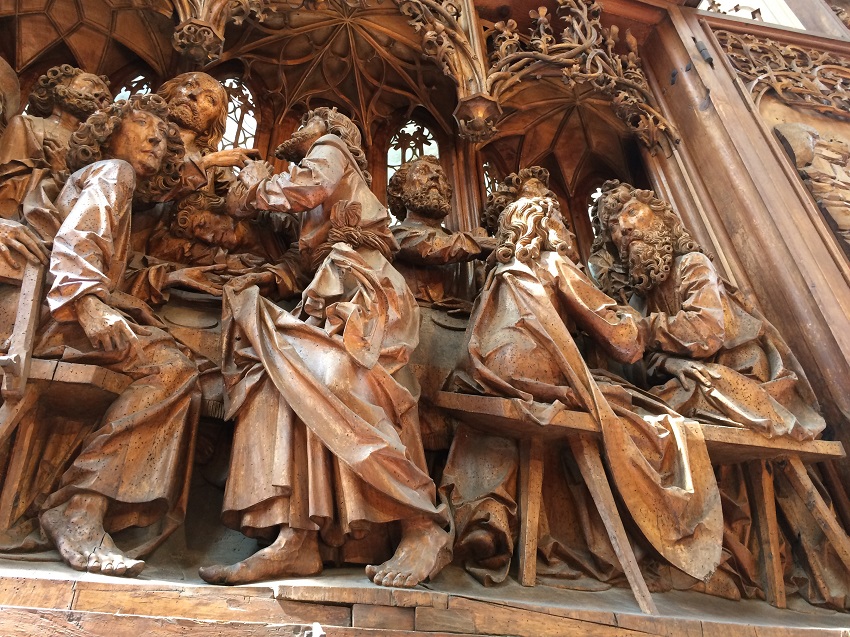
I also found the image and more info online at:
https://en.wikipedia.org/wiki/St._James%27s_Church,_Rothenburg_ob_der_Tauber
Oscar Wilde, in his correspondence with Andre Gide published as part of “Out of the Depths,” his last publication before his death, jokes snidely that Judas’ reason for betraying Jesus was that he had been jilted by Jesus in favor of the much younger John.
From a Christian perspective, I have to ask this: How could Jesus and John be considered in a gay relationship if the Bible says that Jesus was a lamb of God without blemish? If God could destroy cities like Sodom and Gomorrah in a day then how could He be pleased with His Son if he was gay? And how could John write the Book of Revelations if he was gay when he wrote that unrepentant homosexuals would share a part in the second death? Jesus was prophesied since the Old Testament. If He was gay they would have said so. If Jesus and John were gay, how does that play a role in the salvation of everyone else? How does that fit into everything God didn’t want us to do? God does not contradict Himself. It says in the Bible if you couldn’t gently convince a sinner to see the error of their ways, to bring in 2 or 3 more witnesses to talk and confirm with them and if that didn’t work, to get the church involved and if the person was still unconvinced and continued to live with their sin, we Christians are told to treat them as a tax collector or a Gentile. It might seem after all that like we don’t want nothing more to do with the person when in fact, we still want them to feel accepted even though they have chosen to be apart! We are NOT supposed to give up on the sinner! God wouldn’t give up on us so we shouldn’t give up on each other. I have to ask again: Why would Jesus withstand all the whims of the devil only to come out gay? The Bible says how Jesus will spit out the lukewarm because it is neither cold or hot, which means in the spiritual arena, you have to choose a side. The Bible draws a very visible line and makes it clear that you are either with God or you are separated from Him. God IS love but His love is holy. There is nothing holy about homosexuality. It says it in the Bible. He won’t turn a sinner away if they come to Him with a broken spirit and a contrite heart. I say this with love as a fellow Christian. What I did just now by writing this is defending the faith (Ephesians 5:11). And what we need to do AS Christians is follow the advice of (2 Timothy 2:15). We must be careful if we want to teach the Word of God. We must be correct. And we must strive for the Truth. The Truth is not meant to make people feel bad. It’s meant to change lives and save souls. I understand that you opened your article to an audience both gay and Christian. But I respond to you only as a Christian. I am sorry if you were only looking for enthusiasm and support on this topic but I cannot.
You raise many questions, but the basic answer to all of them is that homosexuality is NOT a sin. The Bible is a collection of writings in several languages spanning more than 1,000 years. It was inspired by God but written by humans, so it does include contradictions. We also don’t know if Jesus was gay or not. It’s just a possibility. I recommend the following book for more details:
“What the Bible Really Says about Homosexuality” by Daniel Helminiak
Most Christians and non-believers seem to be unaware of a host of evidence pointing to Christ being gay (https://www.riaanbooysen.com/was-jesus-gay). The reason was that he was physically small, deformed and ugly, so no woman would ever look at him (see Wikipedia – the race and appearance of Christ).
How very beautiful the medal of Jesus kissing John is! When I made my First Holy Communion over sixty years ago, we boys wore a white carnation buttoniere with a white ribbon to which was fastened a round silver-like medal of John resting against Jesus at the Last Supper. Sadly, I lost it sometime during my high school years. Over the years, I have written meditative selections and poetry about the love of Jesus and John. Growing up gay “before Stonewall”, it was a comforting reality to recall in prayer.
Guy, thank you for sharing your beautiful thoughts and experience related to the medal of Jesus kissing John. I love imagining you as a youngster with your white carnation and medal of John resting his head on Jesus. The text accompanying the medal suggested that it would be “perfect for a first communion gift.”
Jesus would have been gay for a very important reason. Remember, the fallen angels in Genesis were cast out of Heaven for marrying and procreating with human women. Heavenly spirits are forbidden to procreate with humans. God wouldn’t deny the gift of companionship and sex to His son, so of course, Jesus was gay. That makes it obvious then to see that John was Jesus’s partner.
Artworks are artists’s interpretations and aren’t absolute and therefore do not define history. However, I would like to thank you for showing everyone what history may might have been based on how one perceives it.
Thank you for so much love as I have also loved you from the deep within. We all are united One in Christ Jesus.
Here is my story. Courtesy the Jesus and Resting John Image I have put in my biography of “Holy Dreams”
https://ahsannabikhan.wordpress.com/christians-realizing-their-jewish-roots/holy-dreams/
This is my first time at this website, and I am enjoying it very much, having been a priest and a sometimes ikonographer in my past. I am sorry, however, to see that big black stars have replaced the reprehensible tradition of the fig leaf on Christopher Olwage’s paintings. It does the artwork no justice, but renders its being to pornographically titillating. St Bonaventure allegedly said that the soul’s desire for mystical union with God is rooted in the human sexual appetite. If sacred art has a place in cultivating that desire, ought it not to be fully visible? Otherwise, the fullness of the Incarnation is negated in a way that seems to make it shameful.
Welcome and thanks for raising a valid point. As publisher, I have to declare whether its content is suitable for general audience, based on external definitions that say male frontal nudity is adult content. If the content here is adult-only, the whole website will become much harder for people to find because it will be restricted on search engines, social media etc. So I choose to limit some nudity in order to reach more people with an LGBTQ-positive spiritual message.
I discussed this with artist Christopher Olwage before posting his work, and he suggested using the black stars rather than omitting or cropping some of his art.
Even with compromises such as the black stars, Q Spirit was just accused of promoting “gay porn” by a conservative Catholic site:
https://www.lifesitenews.com/news/lgbt-ministry-at-new-york-parish-promotes-gay-porn
Their critique focused on my article “Saint Sebastian: History’s first gay icon?”
Right-wing attacks won’t stop me from sharing art that affirms LGBTQ people as part of God’s good creation!
Thanks very much for your thoroughly researched and engaging article, Kitt. Though I have studied the subject of the Beloved Disciple at some length myself, I was unaware of much of the artwork and of the later relationship of John with Prochorus, who went on to become a Bishop. Amazing!
Artwork does not define truth, or history for that matter!